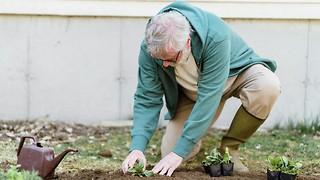Exhibition: Graham Crowley

Currently showing at Churchill College is an exhibition of paintings by the artist Graham Crowley. The exhibition showcases landscapes in Crowley’s most recent style, lending the show as a whole a sense of stylistic unity. However, this style is not one which endears itself to the tastes of all: the two dozen or so paintings are acrid, disconcerting and very contemporary.
Crowley uses very bold, block colours in all the paintings which are displayed. In particular, a burning scarlet colour dominates the exhibition; it almost scars the retina of the viewer. But there are other colours, if less noticeable. Even then, Crowley showcases a clashing palette. Pale yellows rub shoulders with a greyish shade of aubergine, and pale blue accompanies scarlet. Salmon pink is also a favoured tone, often accompanied by acid green and anaemic yellow.
The effect of this sensory overload is not particularly positive. No colour is bright and pure and happy; rather everything has a tinge of grey about it. Nothing is quite as the eye wants it to be. The colours leave the viewer feeling ill at ease; a feeling reinforced by the subject matter. The landscapes depicted are banal – semi-rural streetscapes and corrugated metal sheds – despite the exoticism promised by the colours. The jarring relationship between colour and emotion creates a sinister impression: the bleak pylons dotting the horizons and the deserted streets are suggestive of an apocalyptic situation.
And yet, almost in spite of this mundane discomfort, there are palm trees in the gardens, which promise the exuberance and quasi-mysticism of the paintings of Peter Doig. And in some respects, these qualities can be found in Crowley’s landscapes here, the majority of which play with the viewer’s perception of the landscape by placing it upside-down, reflected in a calm lake which buoys up incongruous little sculls. In one large canvas, the interaction of boats and belly-up houses is actually light-hearted. In this painting, the sinister discomfort otherwise engendered by Crowley’s current style gave way to a party atmosphere – a social squash of the real and the reflected.
Whilst large canvases dominate this show, numerous smaller works on board are also displayed. It is here that I feel the value of this exhibition lies: in contrast to the highly finished texture of the canvases, the board paintings are sketchy and flowing. The colours tend to be less difficult, and in one or two cases are really quite pleasurable to look at. One small painting depicts a rowboat in mustard yellow, with a beautiful blue-grey washed over the yellow ground creating a stunning combination. The rapid ease of these board paintings offsets the depopulated subjects of the canvas. Whilst there is still no life present, the artist himself makes his presence known to the viewer through stray fingerprints and scratch marks on the paint’s surface. I enjoyed looking at these pieces, and for me they made this show worthwhile.
 News / Uni Scout and Guide Club affirms trans inclusion 12 December 2025
News / Uni Scout and Guide Club affirms trans inclusion 12 December 2025 News / Cambridge Vet School gets lifeline year to stay accredited28 November 2025
News / Cambridge Vet School gets lifeline year to stay accredited28 November 2025 Science / Did your ex trip on King’s Parade? The science behind the ‘ick’12 December 2025
Science / Did your ex trip on King’s Parade? The science behind the ‘ick’12 December 2025 News / Cambridge study finds students learn better with notes than AI13 December 2025
News / Cambridge study finds students learn better with notes than AI13 December 2025 News / Pembroke to convert listed office building into accom9 December 2025
News / Pembroke to convert listed office building into accom9 December 2025







